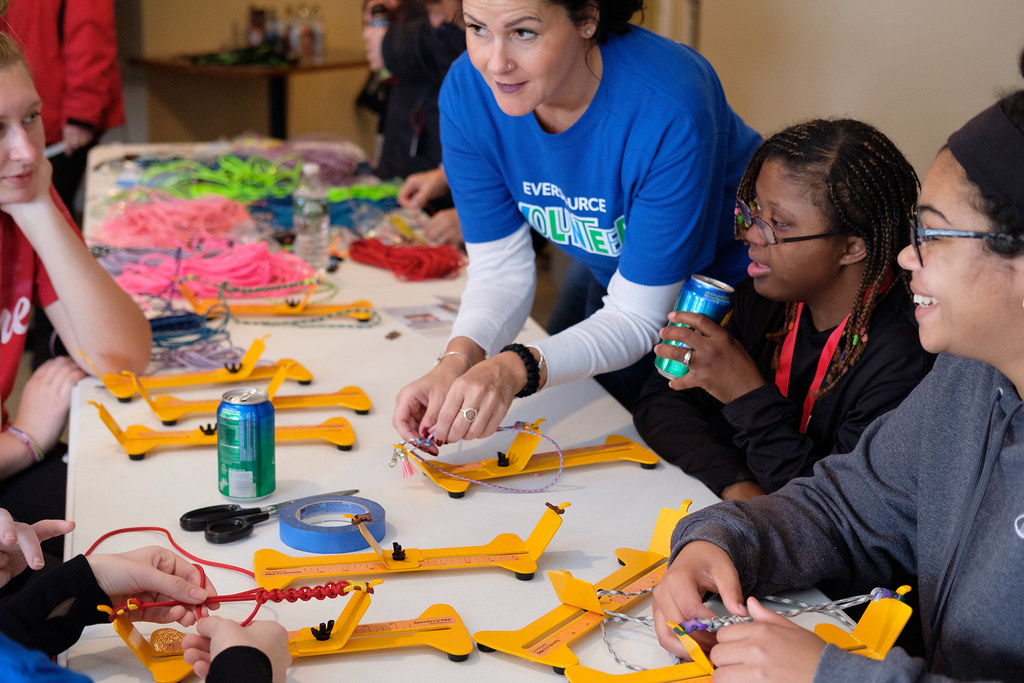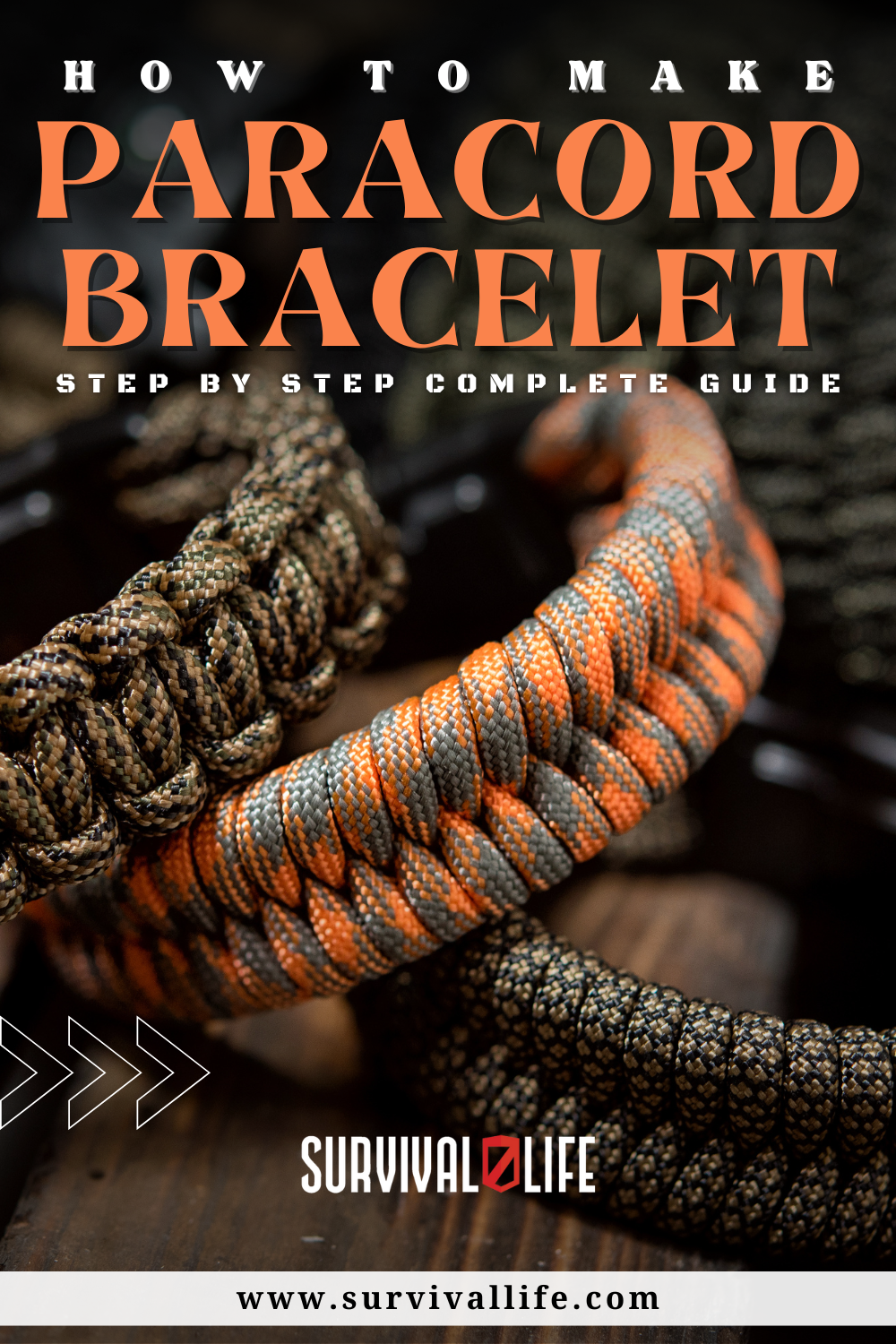Paracord Projects
9 Steps How to Make a Paracord Bracelet

Make a paracord bracelet and have fun creating something cool and unique. This DIY project lets you choose colors and learn different knots to design a unique bracelet. Whether for yourself or as a thoughtful gift, crafting a paracord bracelet is a fun and rewarding experience. So, get your materials, let your creativity flow, and make a bracelet.
A paracord bracelet is a stylish accessory and a practical survival tool. It’s made from durable paracord that can be unraveled and used in emergencies. Whether you’re an outdoor enthusiast or want to create a unique piece of jewelry, making a paracord bracelet is a rewarding craft project. This step-by-step guide walks you through creating your paracord bracelet.
Steps to Make Paracord Bracelet
Step 1: Gather Paracord Bracelet Supplies
1/8 inch diameter paracord in the color(s) of your choice. Your wrist measurement should determine the length of the paracord.
¾ inch plastic side release buckle.
To calculate the length of the paracord needed, follow this guideline:
Approximately 1 inch of bracelet length requires about 1 foot or 12 inches of cord.
For example, if your wrist circumference measures 8 inches, you must count 8 feet or 96 inches of cord.
Tools
Before we dive into the details, let’s gather the necessary tools:
Ruler or tape measure: Using a ruler ensures you achieve the desired fit and prevents the bracelet from being too loose or tight.
Buckle: Opt for a plastic or metal buckle, whichever suits your preference.
Scissors: You’ll need a pair of scissors to cut the paracord to the desired length.
Step 2: Choosing the Right Paracord
Choosing the paracord for your bracelet is essential to ensure its strength, durability, and overall quality. Here are some factors to consider when selecting paracord:
Opt for the authentic 550 paracords, the most common and widely used type. It is named “550” because it has a minimum breaking strength of 550 pounds (approximately 249 kg). This type of paracord is robust, reliable, and suitable for various applications.
Material
Paracord is typically made of nylon, which offers excellent durability and resistance to wear and tear. Nylon paracord is known for its strength, flexibility, and ability to withstand harsh conditions. Ensure that your paracord is made of high-quality nylon for optimal performance.
Core Structure
Paracord consists of an outer sheath and inner strands. The standard 550 paracord has seven inner strands, each comprising two to three smaller strands. This core structure provides added strength and versatility. However, there are other variations of paracord with different core structures, such as micro cord with fewer inner strands.
Color and Design Options
Paracord comes in a wide range of colors, patterns, and designs. Choose a color or design that appeals to you or matches your style. Remember that some bracelets may require specific color patterns or multiple colors for decorative purposes.
Source and Quality
Purchase paracord from reputable sources or reliable suppliers to ensure its authenticity and quality. Read customer reviews and check for certifications or specifications provided by the manufacturer. High-quality paracord will be more reliable and have better performance.
Considering these factors, you can make an informed decision when choosing the suitable paracord for your bracelet. Genuine 550 paracords will ensure your bracelet is strong, durable, and ideal for its intended use.
Step 3: Selecting a Buckle
Next, choose a buckle that complements your paracord. Hooks come in various sizes, shapes, and materials. Plastic clips are lightweight and easy to use, while metal buckles provide durability and a more rugged look. Select a hook that matches your style preferences and the intended purpose of your bracelet.
Step 4: Measuring Your Wrist
Before cutting the paracord, measure your wrist to ensure a proper fit. Wrap the paracord around your wrist and add an inch or two for a comfortable size. This extra length accounts for the knots and the final attachment to the buckle.
Step 5: Attaching the Paracord to the Buckle
To start making the bracelet, pass one end of the paracord through one side of the buckle, and fold it over itself to create a loop. Pull the loose ends of the paracord through the loop and tighten it. It secures the paracord to one side of the buckle.
Step 6: Starting the Knotting Process
Now, it’s time to begin the knotting process. Take the loose ends of the paracord and pass them through the other side of the buckle from underneath. Pull the stops until there’s a small loop on one side. This loop will serve as the starting point for the knots.
Step 7: Continuing the Knotting Pattern
To create the classic cobra knot pattern, follow these steps:
- Please take the right end of the paracord and pass it over the center strands and under the left end.
- Then, pass the left end under the center strands and through the loop created by the right end.
- Pull both ends to tighten the knot.
- Reaching the Desired Length
- Continue repeating the knotting pattern mentioned above to reach the desired length of your bracelet. As you progress, the knots will form a chain-like structure. Remember that the length may vary depending on your wrist size and personal preferences. Don’t forget to periodically check the bracelet’s fit by wrapping it around your wrist.
Step 8: Attaching the Other Side of the Buckle
Once you’ve achieved the desired length, it’s time to attach the other side of the buckle. Pass the loose ends of the paracord through the remaining side of the hook. Ensure the bracelet is not twisted, and adjust the size if needed. Tie a knot or two to secure the paracord to the buckle.
Step 9: Trimming the Excess Paracord
Finally, use scissors to trim any excess paracord, leaving a small tail. Be cautious not to cut the wrong strands. Leave a sufficient length to prevent the bracelet from coming undone. Heat the ends of the paracord with a lighter or heat source to melt and seal them, preventing fraying.
Usage of Paracord Bracelet
Paracord bracelets are versatile. The cord can be divided into smaller strands, each serving different purposes. These smaller strands can be used as fishing lines, sewing thread, dental floss, or constructing a makeshift bowstring.
Furthermore, paracord bracelets are convenient to carry. They can be worn on the wrist, allowing easy access and quick deployment. They take up minimal space and weight, making them ideal for backpacking, camping, or any outdoor activity where lightweight and multipurpose gear is essential.

Paracord bracelets are helpful because they provide a portable source of solid rope, offer versatility, are convenient to carry, and allow personalization. They are a practical and fashionable accessory that can be relied upon in various situations, making them a valuable tool for outdoor enthusiasts, survivalists, and everyday adventurers. With different ideas, a Paracord bracelet for survival could be made.
Share your thoughts with us in the comments section below!
Up Next:
- 3 Basic Paracord Knots For Beginners
- Prepper Kit: 20 Essential Items for Emergency Preparedness
- Paracord Bracelet Supplies: How to Choose
Follow us on Facebook, Instagram, Twitter, and Pinterest!
Disclaimer: All content on this site is for informational purposes only. Please read our full disclaimer here.
-

 Do It Yourself7 months ago
Do It Yourself7 months agoParacord Projects | 36 Cool Paracord Ideas For Your Paracord Survival Projects
-

 Do It Yourself9 months ago
Do It Yourself9 months agoHow To Make Paracord Survival Bracelets | DIY Survival Prepping
-

 Do It Yourself9 months ago
Do It Yourself9 months ago21 Home Remedies For Toothache Pain Relief
-

 Do It Yourself10 months ago
Do It Yourself10 months agoSurvival DIY: How To Melt Aluminum Cans For Casting
-

 Exports8 months ago
Exports8 months agoAre Switchblades Legal? Knife Laws By State

